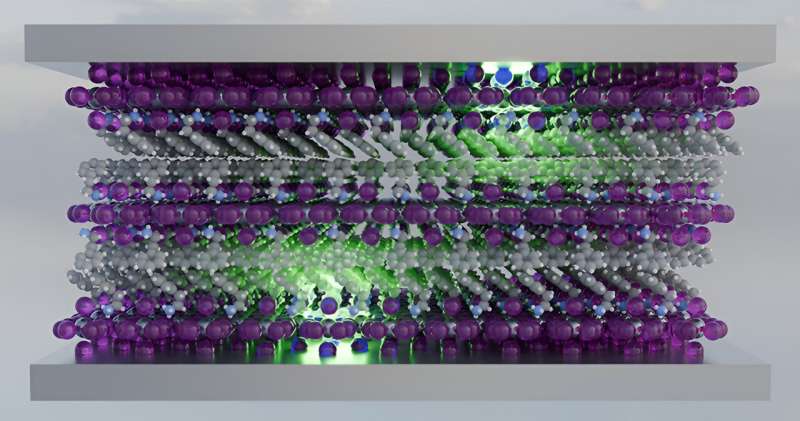
In this artist’s impression of the two-dimensional perovskite PEPI in an optical cavity represented by top and bottom mirrors, lead iodide layers (in metal and violet) are separated by organic phenylethylammonium layers (gray), forming a two-dimensional structure that makes the material excitonic in nature. Two green-glowing excitons avoid interacting with each other due to the presence of the optical cavity. Image credit: Jao van de Lagemaat, NREL
In solar cells and light-emitting diodes, maintaining the kinetics of excited molecular states against their annihilation is a race against time. These systems must find a careful balance between various processes that lead to energy losses and those that lead to the desired result.
A major loss mechanism, especially in the most efficient systems, is the so-called exciton-exciton annihilation, which leads to a reduction in solar efficiency and the light output of LEDs. Controlling the extent of exciton-exciton annihilation is therefore an important lever affecting efficiency.
Researchers at the National Renewable Energy Laboratory (NREL), in collaboration with researchers at the University of Colorado Boulder, attempted to control exciton/exciton annihilation by coupling excitons with cavity polaritons—essentially photons trapped between two mirrors—to counteract energy dissipation and potentially increase the efficiency of optoelectronic devices.
As reported in an article in the Journal of Physical Chemistrythey used transient absorption spectroscopy to demonstrate the control of the loss mechanism by varying the distance between the two mirrors forming the cavity enclosing the 2D perovskite layer (PEA)2PbI4 (PEPI). This perovskite material is a candidate for future LED applications.
“If we could control the exciton/exciton annihilation in the active materials of an LED or a solar cell, we could reduce energy losses and thus significantly increase their efficiency,” said NREL’s Jao van de Lagemaat, director of the Center for Chemistry and Nanoscience, who led the study.
As the energy exchange between light and matter systems exceeds their decay rates, a strong coupling occurs between photonic and electronic states (i.e. excitons), giving rise to polaritons, hybrid states of light and matter.
The NREL researchers demonstrated ultrastrong coupling of the PEPI layer in a Fabry-Pérot microcavity consisting of two partially reflective mirrors. A PEPI layer more strongly coupled to the cavity produced a longer excited state lifetime and gave the researchers control over exciton-exciton annihilation – reducing the loss process by an order of magnitude.
The NREL researchers explained their observation by the quantum nature of the newly formed hybrid states. Polaritons switch back and forth extremely quickly between a more photonic and a more excitonic nature. Since photons do not annihilate each other when they meet, but excitons can, this ghostly “phase shift” between the two particle properties allows polaritons to pass through each other if they are more photonic at the precise moment of their interaction.
Fine-tuning the coupling strength tunes the relative time that polaritons spend as photons, thus allowing control over the energy loss in these systems.
“It was remarkable how such a simple experiment of placing a material between two mirrors completely changed their dynamics,” said Rao Fei, a doctoral student at the University of Colorado Boulder who constructed the cavities and performed ultrafast spectroscopy measurements.
“We have shown that strong coupling effects can be used to control the excited state dynamics of the PEPI system,” said van de Lagemaat. “The simplicity of the system suggests that this result can be transferred to other active materials in LEDs and solar cells and could potentially be integrated into these applications using simple manufacturing methods.”
More information:
Rao Fei et al., Control of Exciton/Exciton Recombination in 2D Perovskites via Exciton-Polariton Coupling, Journal of Physical Chemistry (2024). DOI: 10.1021/acs.jpclett.3c03452
Provided by the National Renewable Energy Laboratory
Quote: Coupling excitons to polaritons for better solar cells and higher intensity LEDs (August 7, 2024), accessed August 7, 2024 from https://phys.org/news/2024-08-coupling-excitons-polaritons-solar-cells.html
This document is subject to copyright. Except for the purposes of private study or research, no part of it may be reproduced without written permission. The contents are for information purposes only.

